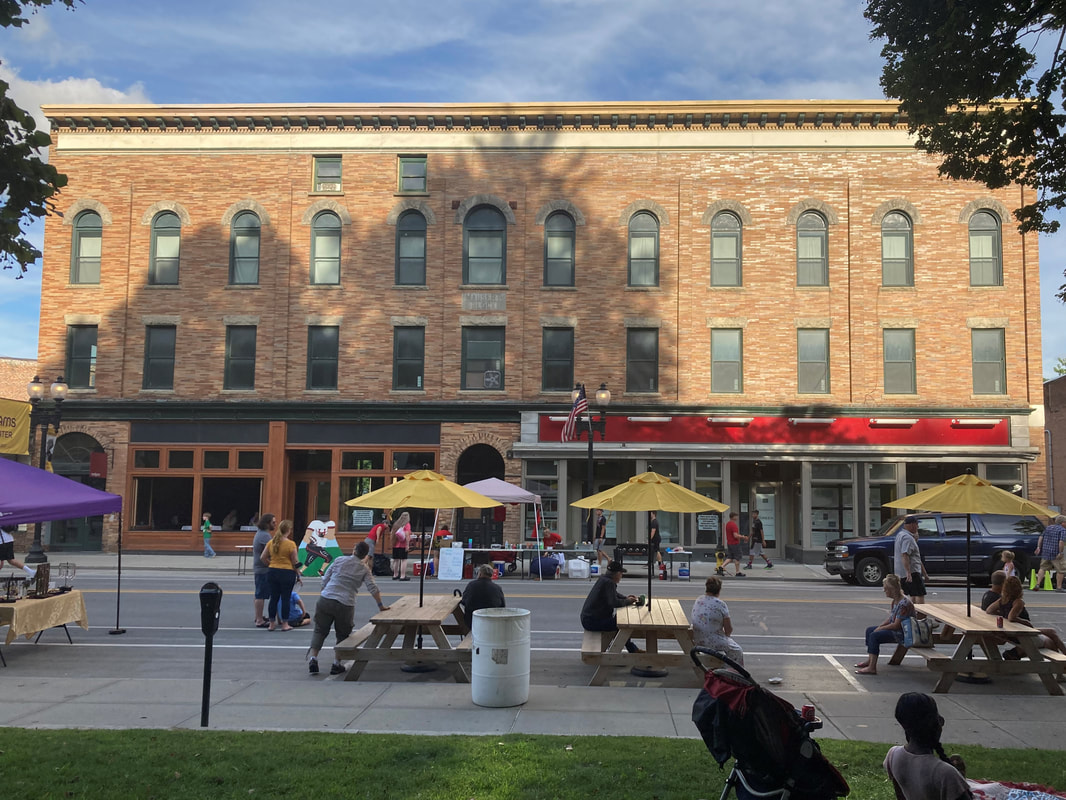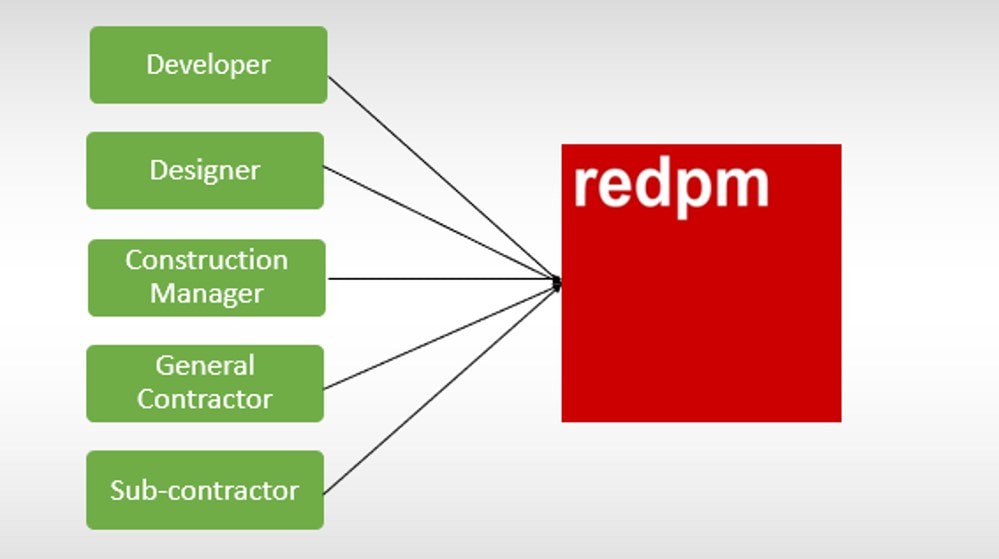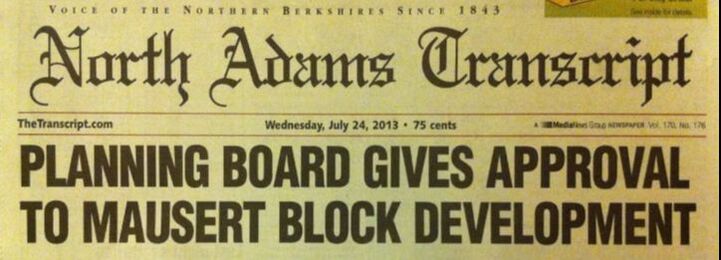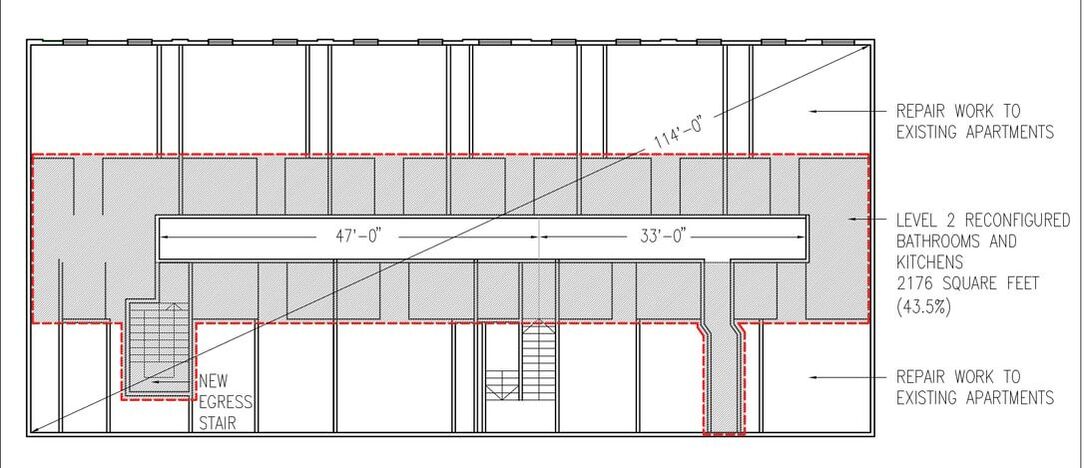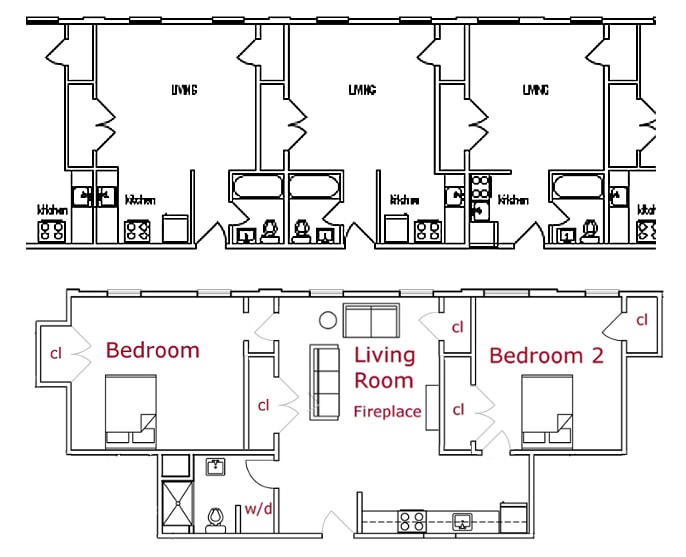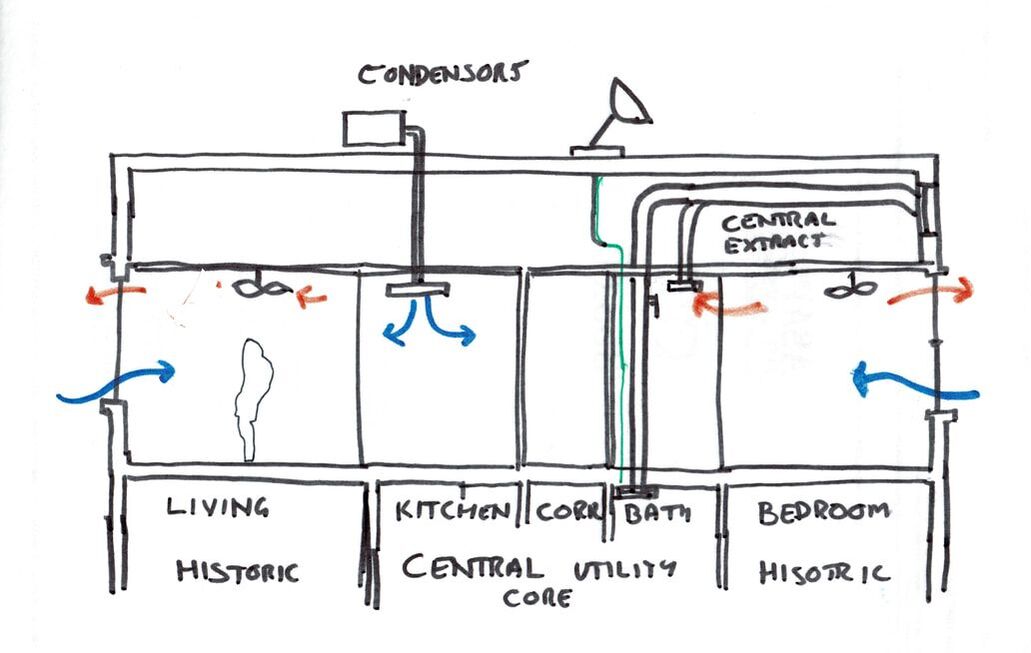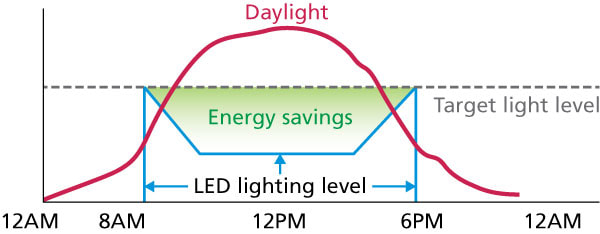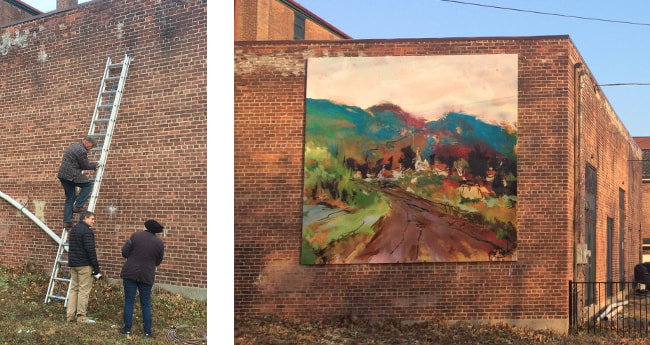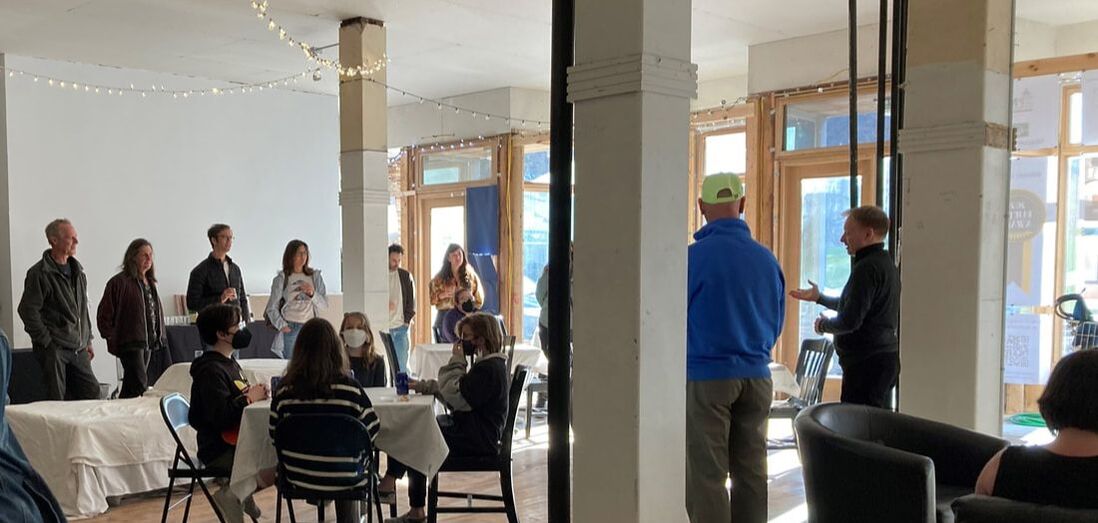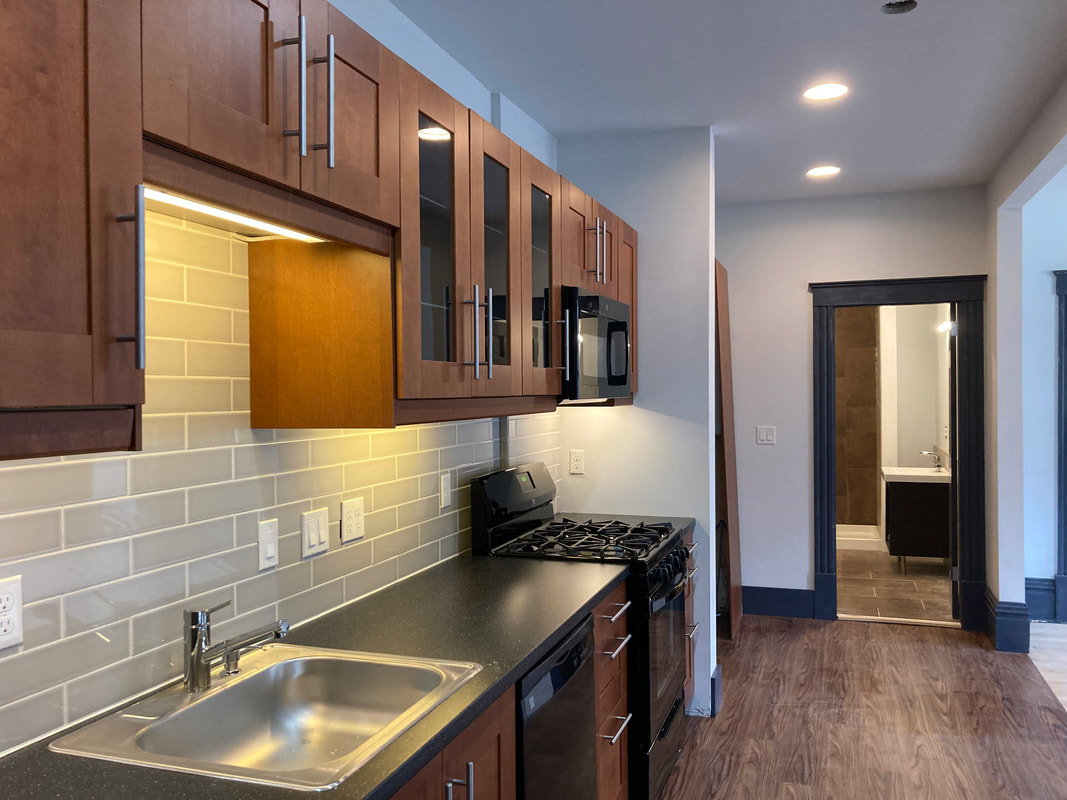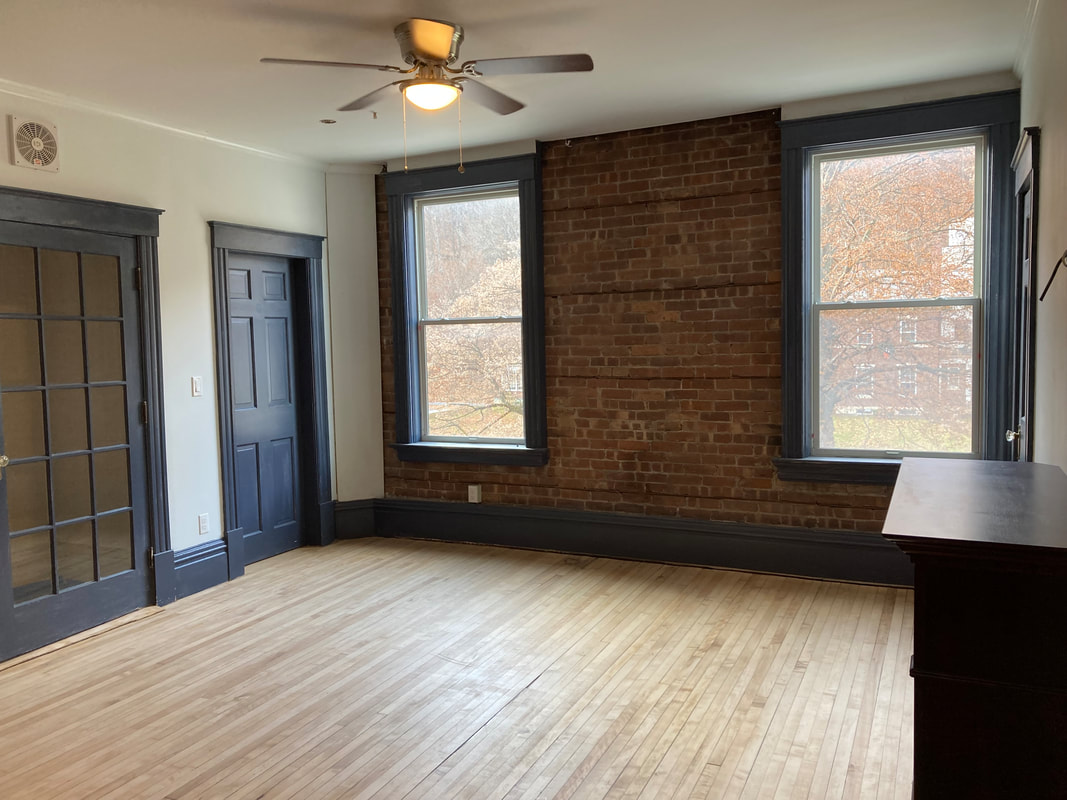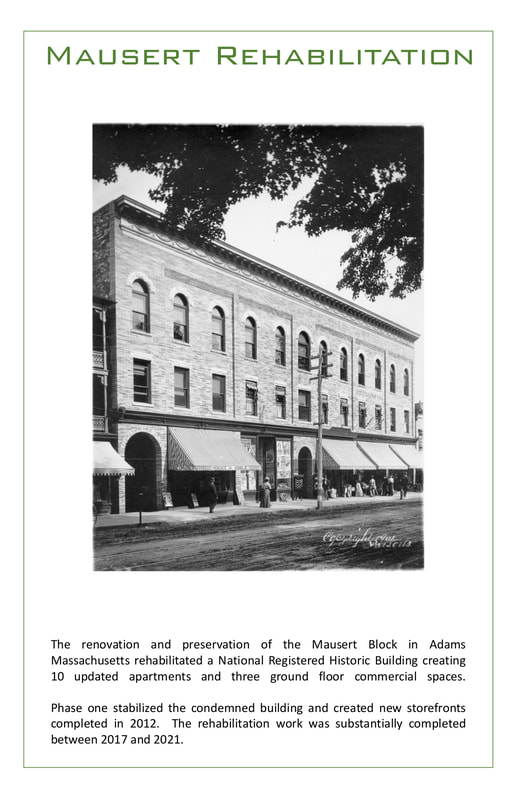
Project Photo Gallery
(opens in new window) |
The Mausert Block, built in 1901, has a prominent location opposite Town Hall in Adams, Massachusetts. Situated in rural Berkshire County, the downtown emptied out in the 1980’s and 1990’s. Despite numerous efforts to regenerate the downtown, the last major private development was completed in 1987. The Mausert Block itself had fallen into disrepair and condemned in 2009. Its rehabilitation was identified by the Town as a key economic flagship and potential catalyst for downtown regeneration.
The Rehabilitation work resulted in the creation of 10 Apartments; renovation of three commercial spaces ready for tenant fit-out; new storefronts and restored fenestration at the back, visually connecting to the rail trail, as well as bringing up the entire 28,000 SF building to current accessibility, ultility and building codes. The development overcame several obstacles - economic, technological, design, regulatory and of course, a pandemic, to create an award winning project. The integration of art, history and innovative sustainable technologies were key elements in the design. Amenities typically expected in new construction, such as electric car charging capability, smart-home technology, and mixed mode air-conditioning, were seamlessly incorporated into the historical building. The first phase was completed in 2012, consisted of storefront replacement and interior stabilization. The interior Historical Rehabilitation commenced in 2017 and continued through the Covid pandemic until substantial completion in 2021. |
The Rehabilitation Work
Major ingress of water resulted in ceiling and floor collapses with flooding in the basement. The existing 18 studio apartments on the upper floors and first floor commercial spaces had deteriorated past their useful life. A full rehabilitation of the 28,000 SF building was required. Conforming to Secretary of the Interior's Standards for the Treatment of Historic Properties, the work consisted of three major alterations –
- Layout changes creating a second means of egress; reconfiguring 18 studio apartments into 10 two-bedroom units; and physically connecting the first floor commercial and residential spaces to new outdoor landscaped areas at the back facing the Ashuwillticook Rail Trail.
- The storefronts on Park Street were replaced and the back fenestration restored. The commercial spaces were made ready for tenant fit-out.
- The building was brought up to current day building codes, ADA requirements, green sustainability practices and utility infrastructure requirements.
Development Team

Photo Credit - Berkshire Trade & Commerce
|
The development team was, quite literally, a ‘Mom and Pop’ enterprise. Having undertaken five gut renovation projects of two-family houses in the area since 2006, Stephen Stenson and Holly Stenson decided to make a full change of career from architecture to developer.
Stephen and Holly Stenson sought a challenging project they would call their ‘big kahuna’. With their skills developed in the field of architecture, previous development experience and the Mausert Block for sale, what could possibly go wrong? Condemned and empty since 2009 and the couple had watched the sale price over the years drop from $600,000, in $100,000 increments until it reached a seemingly bargain price of $199,000. Seeing an opportunity, they lowballed an offer of $60,000. After receiving an immediate acceptance from the foreclosing bank, they realized – “Oh no, what have we done”. So at the end of 2012 they decamped from Boston to Berkshire County with their two boys, aged four and ten months, on a Historical Rehabilitation adventure. |
|
Management Structure
The first challenge was economic and dictated an unusual management structure. The return on investment, either from rental income or re-sale is too low to cover the cost of renovation in Berkshire County. This funding gap has resulted in much less development in the area, compared to the rest of Massachusetts. To drastically reduce costs the Stensons became Developer, Designer, (and acting as redpm), the Construction Manager and General Contractor. The Stensons completed sub-contracting work, such as demolition, dumpster filling, tiling, painting, non-structural carpentry, floor refinishing, kitchen installation, site cleaning, and anything else that needed to be done. The philosophy was, if it potentially catches fire, leaks or falls down, they would get professional sub-contractors to do the work. This innovative ‘flat management’ not only reduced costs but also sped up the design process for any changes that occurred during construction. |
Rural Environment
|
A second challenge was developing in a rural environment. With long term economic decline, several failed developments in town, and a commercial vacancy rate of 50%, no local banks were willing to lend. A state financing agency, MassDevelopment, stepped in to provide a construction loan for the work in 2013. The Agency saw the flat management as a potential prototype for other developments in Western Massachusetts. Supply chain issues and local sub-contractors unfamiliar with commercial construction, particularly code was also a challenge. However, increasing on-site inventory and using their architectural skills in supervising sub-contractors resolved those challenges.
|
|
Innovative Design
An innovative design approach further reduced costs. Demolishing the central third of the building containing kitchen and bathroom areas, allowed the preservation of the historical outer rooms. This limited demolition also had practical advantages. New mechanical, electrical, plumbing and fire alarm systems were run vertically and horizontally without disturbing the historical spaces. The entire building systems and means of egress were brought up to current building code. The design did not trigger the requirement to install automatic sprinkler systems throughout the building, reducing costs further. However, the innovative design resulted in another challenge. A series of four new Building Commissioners over a three-year period, questioned the design, particularly the lack of sprinklers. Ultimately the design efficacy was confirmed at State and local level and work finally re-commenced fully in 2017. The first retail space was opened in late 2018 and in March 2020 the first apartments neared completion. Despite Covid putting the project on a hold, then go-slow, four years after the re-commencement in 2017, the historical rehabilitation was substantially complete at the end of 2021. |
Sustainable and Innovative Technologies
|
Integrating sustainable and emerging technologies were a primary goal of the historical rehabilitation. The apartments were designed to USGBCs (now defunct) ReGreen remodeling program standards.
A hybrid (mixed mode) ventilation system was used to substantially reduce energy costs. Split AC systems, are fed to each apartment and combined with ceiling fans, wall fans, registers and historic internal transom windows, creating natural cross ventilation in the residential spaces. Common areas use daylight harvesting, making the lighting operable only when needed, LED lighting is used throughout and the base building electricity is purchased from 100% renewable sources. |
|
The apartments themselves are individually heated and controlled with high-efficiency (95.9%) combo condensing boilers. Each boiler uses outdoor reset controls and sensors to regulate efficiency. Low water flow shower heads, faucets and toilets were installed reducing water consumption.
Each apartment has a dedicated electric vehicle parking space wired to their individual electrical panel. Smart home technology, with wi-fi thermostats and wi-fi combo washer/dryers are included in each unit. The building has CCTV and video-controlled access systems and is fully wired for high-speed internet, voice, and satellite in each apartment. |
|
Art and Community Outreach
The rehabilitation was designed to accommodate and integrate over 30 pieces of local visual arts and crafts by providing lit spaces and locations for art. Called Maus-ART, curated by the Adams Arts Advisory Board. The Maus-ART program will be part of the Town’s Cultural District application. The local economy benefited with approximately 85% ($2.1M) of the construction dollars spent regionally and 75% ($1.9M) spent in the immediate North Berkshires area. All the sub-contractors and construction personnel, with the exception of roofing, were local. Community outreach was also used to promote the rehabilitation. Stephen Stenson researched the building history and made several public presentations. A series of special articles in the local Transcript Sunday Newspaper in 2013 were part of a coordinated web page roll-out on the detailed history. This outreach came from a belief that ‘Really what creates buildings is the people and stories of people”. |
Conclusion
Using unique management and innovative design, the Stensons were able to complete a $2.5 million rehabilitation for $90 per square foot, and preserve the building’s historic character. The integration of art, history and sustainable technologies were key elements. The use of emerging technologies, such as electric car charging capability, seamlessly incorporated amenities typically expected in new construction into a historical building. This future proofing of the Mausert Block gives value and practicality to the preservation of our building stock, and shows that historical rehabilitation is not only about the past but also about a sustainable future.
Using unique management and innovative design, the Stensons were able to complete a $2.5 million rehabilitation for $90 per square foot, and preserve the building’s historic character. The integration of art, history and sustainable technologies were key elements. The use of emerging technologies, such as electric car charging capability, seamlessly incorporated amenities typically expected in new construction into a historical building. This future proofing of the Mausert Block gives value and practicality to the preservation of our building stock, and shows that historical rehabilitation is not only about the past but also about a sustainable future.
Awards
|
In 2022, the Mausert Block rehabilitation was selected by Preservation Massachusetts for the Robert H. Kuehn, Jr. Award. The other two 2022 recipients were Charles River Speedway in Boston and Harvard University's Swartz Hall in Cambridge. This statewide award is for extraordinary projects that meld collaborative partnerships with creative and cutting-edge ideas for the rehabilitation and active reuse of historic buildings.
In addition the project won the 2022 People's Preservation Choice Award. The project received the most votes from the general public and presented the award at a ceremony at the Boston Copley Plaza Hotel. https://www.preservationmass.org/peoples-preservation-choice |

